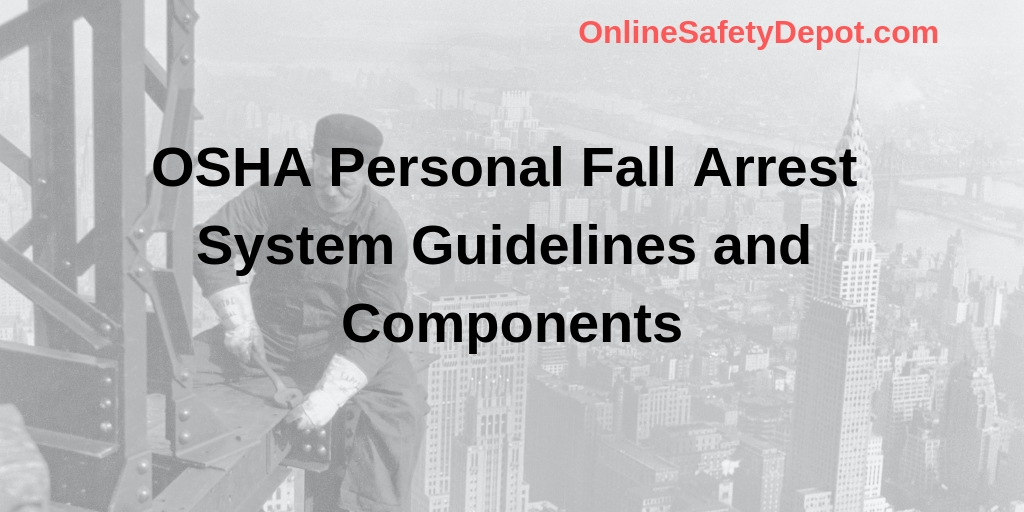OSHA Personal Fall Arrest System Guidelines and Components
Each Year, thousands of workers are injured when working on elevated platforms or while going up and down ladders due to slipping and falling. Prior to 1970, the injury and death count due to falls from elevated platforms such as scaffold, roofs or some other platform was much higher than it is today.
In 1970, Congress and President Nixon formed the Occupational Safety and Health Administration, or OSHA. The administration was formed with the idea and goal of holding employers responsible for creating a safer workplace environment for all their employees.
OSHA works to set and enforce safety standards that will reduce the chances of workplace injuries and death. Over the years, OSHA has provided training, outreach programs and education for businesses to better protect their employees.
The administration has grown over the last 48 years to cover a wide range of safety aspects for businesses in all industries. One of the many guidelines is the ‘Personal Fall Arrest System- 29 CFR 1926.502(d)’ A Personal Fall Arrest System is designed to stop (arrest) a worker who has fallen from a working level.
Components of the Personal Fall Arrest System may include, but is not limited to, the following:
Snaphooks
To meet OSHA guidelines, all snaphooks must be able to lock and prevent disengagement from any component part of the personal Fall Arrest System. Snaphooks need to have a minimum of 5,000 pounds of tensile strength and must be in good working condition, free of rust or sharp edges which could cut, rip or tear the safety rope.
Always use proper fitting snaphooks for the rope size, equipment being used, and the weight needed. Properly designed locking snaphooks may be used to do the following:
- Connect directly to webbing, rope or wire
- Connect directly to each other
- Connect to a Dee-ring where another snaphook is connected
- Connect to any other safety device that is properly designed for the snaphook curved shape and will not disengage the locked snaphook
Horizontal Lifelines (HLL) Systems
Horizontal Lifelines Systems must be designed, installed and supervised by a properly certified person per OSHA Guidelines. They are to be used when a worker is on a scaffold, roof or some other elevated platform in which a worker may fall. Workers need to have the proper Personal Protective Equipment that can attach to the Horizontal Lifeline as designated by OSHA.
The Horizontal Lifeline must have a minimum of two anchor points, and a certifiable cable connecting between the two anchors, thus forming a horizontal line in which the worker is then able to move safely in a horizontal direction. Workers are then able to connect their Personal Protective Equipment to the Horizontal Lifeline. Common places where HLL Systems are used:
- Roof-tops
- Bridges
- Scaffolds
- Construction sites
- Crane boardwalks
Horizontal Lifelines can be placed at the base of the structure, overhead or some place in between the two depending upon the job and work environment.
Vertical Lifelines and Lanyards
While Horizontal Lifelines allow workers to move from side to side, vertical lifelines allow the worker to move safely up and down in setting where a worker is at risk of falling. The Vertical Lifeline allows the worker to be continuously connected between their Personal Protective Equipment (Rope Grab) and the Lifeline.
Rope Grab devices move along the Vertical Lifeline with the worker. In the event a worker falls, the rope grab will lock and not slide down the lifeline cable, thereby stopping the person from falling to the ground.
Ropes and Straps
According to OSHA Guideline 29 CFR 1926.502(d)(14), any ropes, straps, body belts or harnesses must be made of synthetic fibers that are strong and durable to prevent it from breaking should a worker fall.
Anchors
Anchors are the most important part of the Personal Fall Arrest System. If the anchor is improperly installed, the whole system could fail and result in injury or death to the worker it is designed to protect.
Anchors must be independent from any other anchors that are being used to anchor or support the scaffold, boardwalk or other platform.
Conclusion
Since the 1970s, injury and deaths from falls has been dramatically reduced over the years because of the implementation of these safety practices and devices. If you or your workers are working in environments where you are at risk of falling, it is extremely important to have a Personal Fall Arrest System in place to use in conjunction with your PPE and proper adherence to accepted standards.

